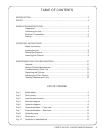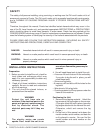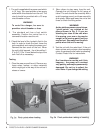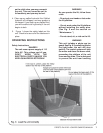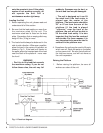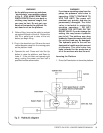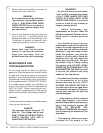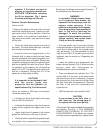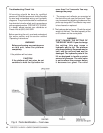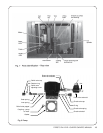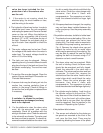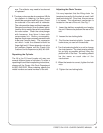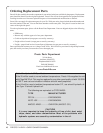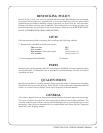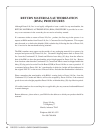
PRESTO P4 LEVEL LOADER OWNER’S MANUAL 11
operator. If the labels are worn or
missing, or have been painted over,
REPLACE THEM before releasing
the lift for operation. Fig. 1 shows
the safety markings on this unit.
Routine Periodic Maintenance
Every month:
• Remove the plate on the rear of the unit and
check the mechanical parts. Inspect the leaf-
type chain which lifts the platform. Check for
signs of wear. If the machine is operated in a
very dusty environment, you may have to wipe
off the dust.
• Check the bolts which anchor the ends of
the chain. The chain should be tight, and each
bolt should be locked in place.
• Check the level and appearance of the
hydraulic fluid. In order to check the level, lower
the unit completely and unplug the power cord.
Remove the rear cover on the unit. Remove the
red plastic vent plug on top of the hydraulic tank,
and use a dipstick to check the oil level. When
the platform is fully lowered, the oil should be
about 1/2’’ to 3/4’’ inch below the top of the tank.
Add oil if necessary. Change the oil if it has
darkened, or feels gritty or sticky.
CAUTION!
It is important to use hydraulic fluid
with the correct grade and
properties. See the hydraulic oil
specification in Fig. 10 of this manual.
Every six months or 500 hours of operation,
whichever comes first:
• Lubricate the lifting chain lightly with spray
lube or SAE 30 mineral oil.
• Lubricate the bushing inside the sheave or
pulley which supports the upper part of the
chain.
• Apply a light coat of grease to the vertical
guides for the rollers on the rear of the unit.
• Check all of the hydraulic fittings and hoses,
and tighten the connections if necessary.
Sometimes the fittings can be worked loose by
the vibrations from the power unit.
WARNING!
If a hydraulic fitting becomes loose,
or if a hydraulic hose breaks, the
hydraulic fluid may escape from the
system under pressure. If the
platform is raised when this happens,
it can drop quickly. Someone may be
hurt, or the unit or load may be
damaged. To avoid this problem,
inspect all of the hydraulic hoses and
fittings regularly, and replace them
if they are worn or damaged.
• The clear plastic vent line and the cylinder
rod should be free of hydraulic fluid. If you find
much fluid in either place, the cylinder seals
may be leaking. (It is also possible the tank
may be over-filled.) If the worn parts must be
replaced, see the section on “Repacking the
Cylinder.”
• Lower the platform and disassemble the
down valve as shown in Fig. 8. Blow the valve
plunger clean with compressed air.
Reassemble the valve and reinstall it.
• Drain and discard the hydraulic fluid. The
suction filter is in the tank, at the point where
the suction line runs out to the pump. Unscrew
the hydraulic line, then remove the filter. Blow
the filter clean with compressed air. Reinstall
the filter in the tank and reassemble the
hydraulic line.
• Refill the tank with new hydraulic fluid.
CAUTION!
If you continue to use fluid after it
has “worn out,” the moving parts in
the system will wear more quickly.
• Be sure all of the warning labels are in position
and legible. See Fig. 1. THE WARNING
LABELS ARE INTENDED TO PROTECT
YOUR WORKERS. If the labels are missing,
or if they have been painted over, replace them.



